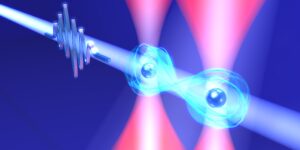
- This event has passed.
Ultrafast quantum simulation and quantum computing with ultracold atom arrays at quantum speed limit
May 30 @ 10:00 am - 11:00 am
Abstract: Many-body correlations drive a variety of important quantum phenomena and quantum machines including superconductivity and magnetism in condensed matter as well as quantum computers. Understanding and controlling quantum many-body correlations is thus one of the central goals of modern science and technology. My research group has recently pioneered a novel pathway towards this goal with nearby ultracold atoms excited with an ultrashort laser pulse to a Rydberg state far beyond the Rydberg blockade regime [1-7]. We first applied our ultrafast coherent control with attosecond precision [2,3] to a random ensemble of those Rydberg atoms in an optical dipole trap, and successfully observed and controlled their strongly correlated electron dynamics on a sub-nanosecond timescale [1]. This new approach is now applied to arbitrary atom arrays assembled with optical lattices or optical tweezers that develop into a pathbreaking platform for quantum simulation and quantum computing on an ultrafast timescale [4-7].
In this ultrafast quantum computing, as schematically shown in Fig. 1, we have recently succeeded in executing a controlled-Z gate, a conditional two-qubit gate essential for quantum computing, in only 6.5 nanoseconds at quantum speed limit, where the gate speed is solely determined by the interaction strength between two qubits [5]. This is faster than any other two-qubit gates with cold-atom hardware by two orders of magnitude. It is also two orders of magnitude faster than the noise from the external environment and operating lasers, whose timescale is in general 1 microsecond or slower, and thus can be safely isolated from the noise. Moreover, this two-qubit gate is faster than the fast two-qubit gate demonstrated recently by “Google AI Quantum” with superconducting qubits [8].

Figure 1. Conceptual diagram of the ultrafast twoqubit gate for quantum computing with cold atoms. Two single atoms captured in optical tweezers (red light) with a separation of a micrometer are entangled with an ultrafast laser pulse (blue light) shone for only 10 picoseconds [5]. Image source: Dr. Takafumi Tomita (IMS).
References
[1] N. Takei et al., Nature Commun. 7, 13449 (2016).
Highlighted by Science 354, 1388 (2016); IOP PhyscisWorld.com (2016).
[2] H. Katsuki et al., Acc. Chem. Res. 51, 1174 (2018).
[3] C. Liu et al., Phys. Rev. Lett. 121, 173201 (2018).
[4] M. Mizoguchi et al., Phys. Rev. Lett. 124, 253201 (2020).
[5] Y. Chew et al., Nature Photonics 16, 724 (2022). (Front Cover Highlight)
[6] V. Bharti et al., Phys. Rev. Lett. 131, 123201 (2023).
[7] V. Bharti et al., arXiv:2311.15575 (2023).
[8] B. Foxen et al., Phys. Rev. Lett. 125, 120504 (2020).
Speaker Bio: Kenji Ohmori is a Chair Professor at the Institute for Molecular Science (IMS), National Institutes of Natural Sciences, Japan. After receiving his Ph.D. from The University of Tokyo in 1992, he was a Research Associate and an Associate Professor at Tohoku University. In 2003 he was appointed a Full Professor at IMS.
Professor Ohmori is currently leading large-scale / long-term national projects on the development of ultrafast quantum simulators and quantum computers (2018-2030) generously supported with priority by the Ministry of Education, Culture, Sports, Science and Technology (MEXT) and Cabinet Office of the government of Japan, expected as one of the front runners in quantum technologies.
He has been celebrated with many honors. Highlights include the Japan Academy Medal (2007), Fellow of the American Physical Society (2009), Humboldt Research Award from the government of Germany (2012), Commendation for Science and Technology by the Minister of MEXT (2018), and the Medal with Purple Ribbon by His Majesty the Emperor of Japan for his achievements on quantum physics (2021). The Medal with Purple Ribbon is awarded for inventions and discoveries in science and technology, and for outstanding achievements in the fields of science, sports, art and culture.
Professor Ohmori is currently serving as the Chair of the Committee for Quantum Science and Technology Policy, MEXT, Japan since 2023, after serving as the Vice Chair of the same committee from 2015-2022.
It was officially announced in February 2024 that Professor Ohmori and his team established the “Commercialization Preparatory Platform” for their “cold (neutral) atom” quantum computer where 13 topnotch industries have joined, including Development Bank of Japan Inc., Hitachi, Ltd., Fujitsu Limited, NEC Corporation, and Hamamatsu Photonics K.K. The relevant start-up company will be launched within the Japanese Fiscal Year 2024.